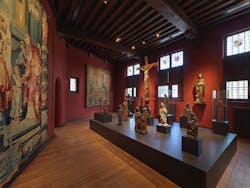Stoane and Xicato light the restored Gruuthusemuseum in Belgium with LEDs
Renaissance-era lord Lodewijk (Louis) van Gruuthuse would likely be very impressed could he visit his one-time Bruges, Belgium city palace that now sports a state-of-the-art LED-based lighting system and comprehensive controls implementation. Indeed, the restored Gruuthusemuseum reopened after five years of work on the facility not long before the pandemic hit, and only recently have curators been able to documents the results of the undertaking. The museum covers 500 years of Bruges history going back to medieval times through a collection of applied and decorative art. The new solid-state lighting (SSL) enhances the visitor experience and will ultimately help preserve the exhibits for future generations.
A multi-faceted team collaborated on the Gruuthusemuseum project led by museum coordinator Aleid Hemeryck. Netherlands-based lighting consultant Joost de Beij worked on the design that was supplied by distributor The Lux Company. The exhibits are lit primarily by luminaires from Scotland-based Stoane Lighting that use Xicato LED light engines. As we mentioned in an article recently, Xicato is known for its focus on lumen and color maintenance.
Gruuthusemuseum exhibits span portraits to artistic porcelain to tapestries and more. The museum sought to create an atmosphere that evoked serenity and warmth. “Adapted lighting plays a leading role in this,” said coordinator Hemeryck. “The lighting brings the art objects and the building to life. In almost every museum, she makes or breaks the experience. A well thought-out lighting concept is also crucial for the maximum preservation of the collection. Old works of art are particularly sensitive to light, which means there is a real risk of damage if they are exposed too intensely for too long.” Indeed, when we first began covering SSL museum projects a decade ago, protecting the works was one of the earliest justifications for LEDs. We found an Italian project that made such a point all the way back in 2008.
The museum project is unique in that the ambient lighting and the object lighting are quite different. The general lighting uses DALI (Digital Addressable Lighting Interface)-based controls. The Xicato-based object lighting uses the Bluetooth Mesh-based wireless network integrated on the Xicato modules. Helvar Lighting Controls was able to interface both systems for unified control by the iRidium building management platform.
Xicato won a spot in the project both because of the light quality of its modules and the controls functionality. A wireless scheme is critical in restorations of historically listed museums such as the Gruuthusemuseum because no new cable need be run. We have covered such advantages before including in an Oxford University listed building a few years back.
About his company’s SSL modules, Patrick van der Meulen, business development manager at Xicato, said, “They have some unique properties. This means that the luminous flux and color consistency are better maintained over the entire lifespan than with most other LEDs on the market. This is a special asset for museums because light is not purely functional there: The lighting influences the way in which art is experienced.”
The controls brought other advantages. “In addition, numerous sensors are built into our LED modules,” continued van der Meulen. “On the one hand, these protect the LEDs, among other things through temperature monitoring. On the other hand, the sensors allow [the museum] to create additional functionality for lighting and other applications. For example, the built-in beacons allow location-driven services. For example, we think of an application that provides information on the smartphone or tablet of the visitors about the art object they represent.”
The museum representative even said they are considering the use of sensor data to enforce social distancing during the COVID-19 pandemic. They will also track the amount of time an object is exposed to light and possibly use that information to rotate items off display.
Still, it’s the experience that is paramount and the museum staff has finally had the ability to gather enough feedback to evaluate the project. “We receive a lot of compliments about the atmosphere in the museum,” says Hemeryck. “That means that the lighting fulfills its role with flying colors. We are convinced that the solution will also meet expectations in terms of energy efficiency, flexibility, and quality. Now it is up to us to further exploit the smartness of the system.”
For up-to-the-minute LED and SSL updates, why not follow us on Twitter? You’ll find curated content and commentary, as well as information on industry events, webcasts, and surveys on our LinkedIn Company Page and our Facebook page.

Maury Wright | Editor in Chief
Maury Wright is an electronics engineer turned technology journalist, who has focused specifically on the LED & Lighting industry for the past decade. Wright first wrote for LEDs Magazine as a contractor in 2010, and took over as Editor-in-Chief in 2012. He has broad experience in technology areas ranging from microprocessors to digital media to wireless networks that he gained over 30 years in the trade press. Wright has experience running global editorial operations, such as during his tenure as worldwide editorial director of EDN Magazine, and has been instrumental in launching publication websites going back to the earliest days of the Internet. Wright has won numerous industry awards, including multiple ASBPE national awards for B2B journalism excellence, and has received finalist recognition for LEDs Magazine in the FOLIO Eddie Awards. He received a BS in electrical engineering from Auburn University.





